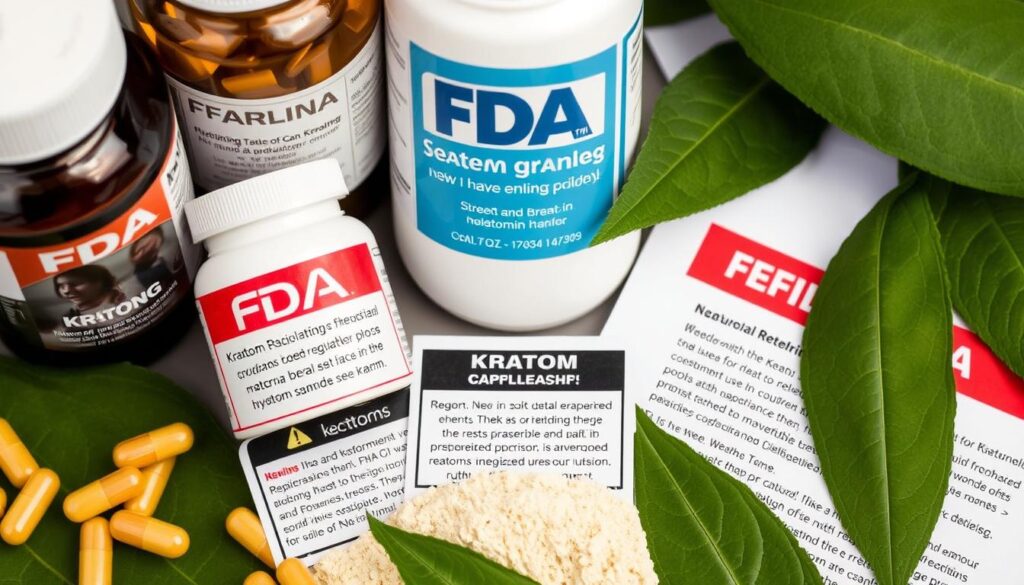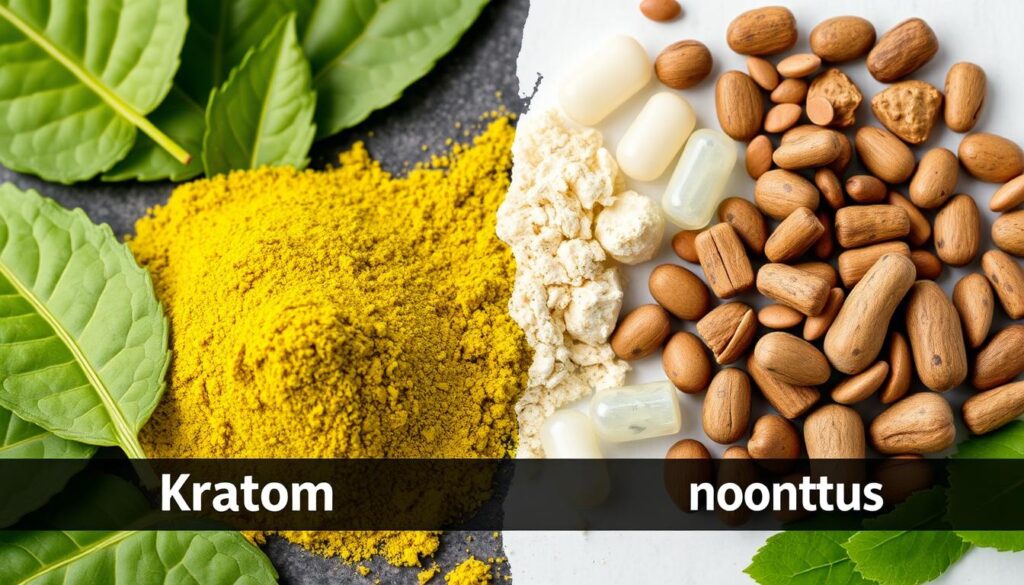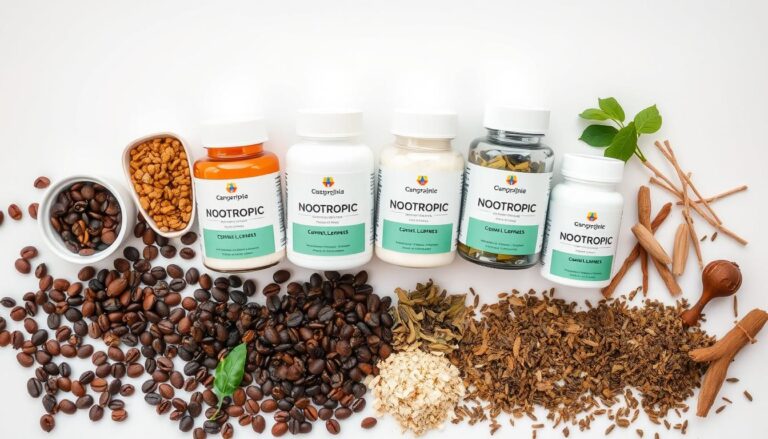
This guide examines the science behind nootropics and kratom, providing evidence-based insights into their mechanisms, benefits, and potential risks. Whether you’re new to cognitive enhancers or looking to expand your knowledge, understanding these substances is essential for making informed decisions about brain health.
What Are Nootropics?
Nootropics come in various forms, from natural substances like caffeine to synthetic compounds
Nootropics (pronounced noh-ə-TROHP-iks or noh-ə-TROP-iks) are substances that purportedly enhance cognitive functions such as memory, creativity, motivation, and attention. The term was coined in 1972 by Romanian psychologist Corneliu Giurgea, who established specific criteria for what constitutes a true nootropic.
According to Giurgea’s original definition, nootropics should:
- Enhance learning and memory
- Protect the brain from physical or chemical injury
- Increase the efficacy of neuronal firing control mechanisms
- Possess few side effects and extremely low toxicity
- Lack the usual pharmacology of other psychotropic drugs
Today, the definition has broadened to include many substances that may improve some aspect of mental function, even if they don’t meet all of Giurgea’s criteria. Nootropics include prescription drugs, dietary supplements, and synthetic compounds marketed to enhance brain performance.
The global nootropics market was valued at $2.17 billion in 2020 and is projected to reach $5.32 billion by 2026, growing at a CAGR of 13.2% during the forecast period.
Common Types of Nootropics
Nootropics can be categorized into several groups based on their origin, mechanism of action, and regulatory status. Here’s an overview of the most common types:

Natural Nootropics
Natural nootropics are derived from plants, herbs, and other naturally occurring substances. They typically have milder effects and a longer history of human use.
| Nootropic | Source | Primary Benefits | Research Support |
| Caffeine | Coffee, tea, cocoa | Increased alertness, improved attention, decreased reaction time | Strong |
| L-Theanine | Tea leaves | Calm alertness, reduced stress, enhanced creativity | Moderate |
| Bacopa Monnieri | Herb | Improved memory, reduced information processing time | Moderate |
| Ginkgo Biloba | Tree leaves | Enhanced memory in older adults, improved blood flow to brain | Mixed |
| Panax Ginseng | Root | Reduced mental fatigue, improved performance on difficult tasks | Limited |
Synthetic Nootropics
Synthetic nootropics are laboratory-created compounds designed specifically to enhance cognitive function. The racetam family represents the most well-known category of synthetic nootropics.

Racetams
- Piracetam – The original nootropic, may improve memory in aging individuals
- Aniracetam – Potentially enhances mood and creativity
- Oxiracetam – May improve logical thinking and analysis
- Pramiracetam – Reported to enhance learning and memory formation
Other Synthetics
- Noopept – Fast-acting with potential memory-enhancing effects
- Phenylpiracetam – May improve physical performance and cold tolerance
- Modafinil – Prescription wakefulness promoter with cognitive effects
- Adrafinil – Metabolizes into modafinil in the body
Important Note: The FDA has warned that many synthetic nootropics sold as dietary supplements may be misbranded or contain unapproved drugs. In 2019, the FDA and FTC issued warnings about advertising fraud and marketing scams related to nootropic supplements.
Kratom: An Emerging Cognitive Enhancer

Kratom (Mitragyna speciosa) leaves and powder form used traditionally in Southeast Asia
Kratom (Mitragyna speciosa) is a tropical tree native to Southeast Asia, particularly Thailand, Malaysia, Indonesia, and Papua New Guinea. While not traditionally classified as a nootropic, kratom has gained attention for its potential cognitive effects and is increasingly discussed alongside other cognitive enhancers.
Origin and Traditional Use
For centuries, indigenous populations in Southeast Asia have used kratom leaves for their medicinal properties. Workers would chew the leaves or brew them as tea to combat fatigue and increase productivity during long hours of manual labor. Traditional uses include pain relief, energy enhancement, and as a substitute for opium.
Active Compounds and Mechanism of Action
Kratom contains over 40 alkaloids, with mitragynine and 7-hydroxymitragynine being the primary active compounds. These alkaloids interact with opioid receptors in the brain, but in a unique way that differs from traditional opioids:
- At low doses (1-5 grams), kratom primarily activates alpha-adrenergic receptors, producing stimulant-like effects
- At higher doses (5-15 grams), it increasingly activates mu-opioid receptors, resulting in sedative and analgesic effects
- Unlike classic opioids, kratom is a partial agonist of these receptors, which may explain its reduced respiratory depression risk
This dual action makes kratom unique among substances that affect cognitive function, as its effects can vary significantly based on dosage.
Potential Cognitive Benefits of Kratom

Research on kratom’s cognitive effects remains limited, but anecdotal reports and preliminary studies suggest several potential benefits:
Focus and Concentration
At lower doses, kratom may produce stimulant-like effects that enhance focus and concentration. Users report increased productivity and ability to maintain attention on tasks for extended periods. This effect is likely due to the interaction with adrenergic receptors and increased dopamine release.
Mood Enhancement
Kratom may elevate mood through its interaction with serotonergic and dopaminergic pathways. This mood enhancement can indirectly improve cognitive performance by reducing anxiety and increasing motivation. A 2020 survey of kratom users found that improved mood was among the most commonly reported benefits.
Energy and Motivation
Similar to caffeine but through different mechanisms, kratom may increase energy levels and motivation. This stimulation can help overcome mental fatigue and enhance work performance. Traditional use by manual laborers in Southeast Asia supports this application.
Stress Reduction
Some users report that kratom helps manage stress and anxiety, which can indirectly improve cognitive function by reducing the negative impact of stress hormones on brain performance. However, this effect is typically more pronounced at moderate to higher doses.
A 2022 study published in the Journal of Psychoactive Drugs surveyed 2,798 kratom users and found that 91% reported using it for mental health conditions, with 40% specifically mentioning cognitive benefits such as improved focus and mental clarity.
Risks and Controversies Surrounding Kratom

Despite potential benefits, kratom use comes with several concerns that must be carefully considered:
Potential Benefits
- Enhanced focus and concentration
- Mood elevation
- Increased energy and motivation
- Stress reduction
- Pain management potential
Potential Risks
- Dependence and withdrawal symptoms
- Inconsistent product quality and purity
- Potential liver toxicity
- Drug interactions
- Limited research on long-term effects
Addiction Potential
Kratom can cause physical dependence with regular use. A 2020 systematic review published in the Journal of Addiction Medicine found that regular users may experience withdrawal symptoms including muscle aches, insomnia, irritability, and mood disturbances when discontinuing use. The addiction potential appears lower than that of traditional opioids but remains a significant concern.
Quality and Contamination Issues
The FDA has identified multiple kratom products contaminated with heavy metals and harmful bacteria. Without standardized manufacturing practices, product quality varies widely, posing additional risks to consumers.
Stay Informed About Nootropic Safety
Get our comprehensive guide to using nootropics and kratom safely, including dosage guidelines, potential interactions, and harm reduction strategies.
Comparing Kratom with Traditional Nootropics

How does kratom compare to established nootropics? This comparison highlights key differences and similarities:
| Feature | Kratom | Natural Nootropics (e.g., Caffeine) | Synthetic Nootropics (e.g., Racetams) |
| Primary Mechanism | Opioid receptor and adrenergic activity | Various (adenosine antagonism, etc.) | Glutamate modulation, acetylcholine enhancement |
| Onset of Effects | Relatively rapid (15-30 minutes) | Rapid (minutes to hours) | Variable (hours to weeks) |
| Duration | 4-6 hours | 3-5 hours (caffeine) | 4-8 hours (varies widely) |
| Dependence Risk | Moderate | Low to moderate (caffeine) | Generally low |
| Research Quality | Limited, emerging | Extensive (for some) | Moderate |
| Legal Status | Varies by country/region | Generally legal | Varies (some prescription-only) |
Key Differences
Unlike most traditional nootropics, kratom:
- Has significant effects on mood and pain perception due to its opioid receptor activity
- Produces dose-dependent effects that can shift from stimulating to sedating
- Carries a higher risk of dependence and withdrawal
- Faces more regulatory scrutiny and legal restrictions
These differences highlight why kratom occupies a unique position in the cognitive enhancement landscape—not fully aligned with traditional nootropics but sharing some overlapping effects and applications.
Safety Guidelines for Using Nootropics and Kratom

Proper measurement and record-keeping are essential for safe nootropic use
If you’re considering using nootropics or kratom, following these safety guidelines can help minimize risks:
General Safety Principles
Research Thoroughly
Before trying any cognitive enhancer, research its effects, side effects, interactions, and legal status. Rely on peer-reviewed studies rather than anecdotal reports or marketing claims.
Start with Low Doses
Begin with the lowest effective dose and increase gradually if needed. This approach, known as “start low, go slow,” helps minimize adverse reactions and allows you to find your optimal dosage.
Consult Healthcare Providers
Discuss your interest in nootropics with healthcare professionals, especially if you have existing health conditions or take medications. Many substances can interact with prescription drugs.
Verify Product Quality
Purchase from reputable vendors who provide third-party testing results. Look for certificates of analysis that verify purity and potent content.
Specific Guidelines for Kratom
Kratom Safety Checklist:
- Verify legality in your region before purchasing
- Start with no more than 1-2 grams for first-time users
- Wait at least 24 hours between doses to assess effects
- Avoid combining with other substances, especially CNS depressants
- Stay hydrated while using kratom
- Take regular breaks to prevent tolerance and dependence
- Store securely away from children and pets
Cycling and Tolerance Management
To prevent tolerance development and maintain effectiveness, consider implementing cycling strategies:
- Scheduled breaks: Take regular breaks from nootropic use (e.g., weekends off, one week per month)
- Rotation: Alternate between different nootropics with similar effects but different mechanisms
- Minimum effective dose: Use the smallest dose that provides benefits
- Stack responsibly: When combining nootropics, research potential interactions and start with lower doses of each component
Track Your Nootropic Experience
Download our free nootropic journal template to track effects, dosages, and find your optimal cognitive enhancement regimen.
Legal Status of Kratom and Nootropics

Global legal status of kratom varies significantly by country and region
The regulatory landscape for nootropics and especially kratom varies widely across different regions. Understanding the legal status is essential before purchasing or traveling with these substances.
Kratom Legal Status
| Region | Legal Status | Notes |
| United States | Varies by state | Legal federally but banned in Alabama, Arkansas, Indiana, Rhode Island, Vermont, and Wisconsin. Regulated in several other states. |
| European Union | Varies by country | Illegal in Denmark, Finland, Ireland, Latvia, Lithuania, Poland, Romania, and Sweden. Legal or unregulated in other EU countries. |
| Australia | Illegal | Classified as a Schedule 9 prohibited substance since 2003. |
| Canada | Legal with restrictions | Legal for purchase but not approved for consumption by Health Canada. |
| Southeast Asia | Mostly illegal | Illegal in Thailand (despite recent medical legalization), Malaysia, and Myanmar. Legal in Indonesia but export will be banned starting 2024. |
Nootropic Regulations
Most natural nootropics are regulated as dietary supplements in the United States and many other countries, meaning they can be sold without proving efficacy but cannot make specific medical claims. Synthetic nootropics face varying regulations:
- Racetams: Not approved for medical use in the US but often sold as “research chemicals.” Prescription-only in some European countries.
- Modafinil: Prescription-only in most countries, classified as a controlled substance in the US.
- Prescription stimulants: (Adderall, Ritalin) Controlled substances requiring a prescription worldwide.
- Natural supplements: (Bacopa, Ginkgo) Generally legal but subject to quality and marketing regulations.
Important: Legal status can change rapidly. Always verify current regulations before purchasing or traveling with nootropics or kratom. This information is current as of 2023 but should not be considered legal advice.
Check Kratom Legality In Your Area
Use our interactive tool to check the current legal status of kratom in your specific location and stay updated on pending legislation.
Conclusion: Making Informed Decisions

Nootropics and kratom represent different approaches to cognitive enhancement, each with distinct mechanisms, benefits, and risks. While traditional nootropics like caffeine, L-theanine, and racetams have more established research profiles, kratom remains in a gray area with promising anecdotal reports but limited scientific validation.
The key to safely navigating the world of cognitive enhancers lies in thorough research, cautious experimentation, and honest assessment of your needs and risks. Consider these final recommendations:
- Prioritize lifestyle factors like sleep, exercise, and nutrition as the foundation of cognitive health
- Start with well-researched natural nootropics before exploring more experimental options
- Approach kratom with extra caution due to its dependence potential and legal complexities
- Document your experiences systematically to identify what works best for your unique biology
- Stay informed about emerging research and regulatory changes
The field of cognitive enhancement continues to evolve rapidly. By approaching nootropics and kratom with a balanced perspective—neither dismissing their potential benefits nor ignoring their risks—you can make informed decisions that support your cognitive goals while protecting your long-term health.
Stay Updated on Nootropic Research
Subscribe to our monthly newsletter for the latest scientific findings, safety information, and expert analysis on nootropics and cognitive enhancement.



